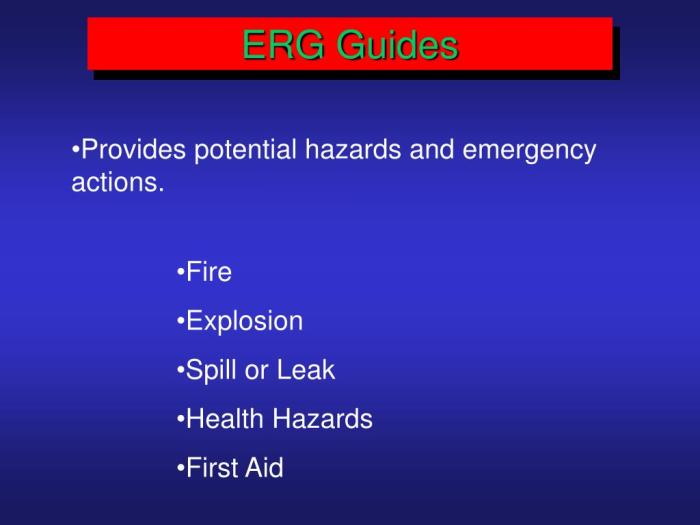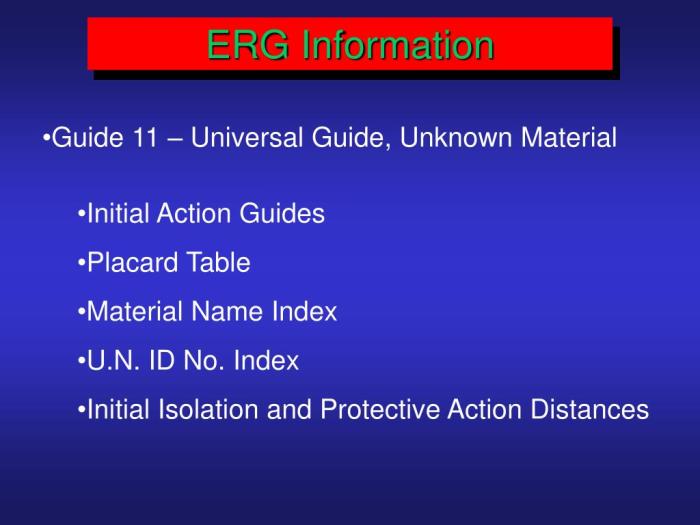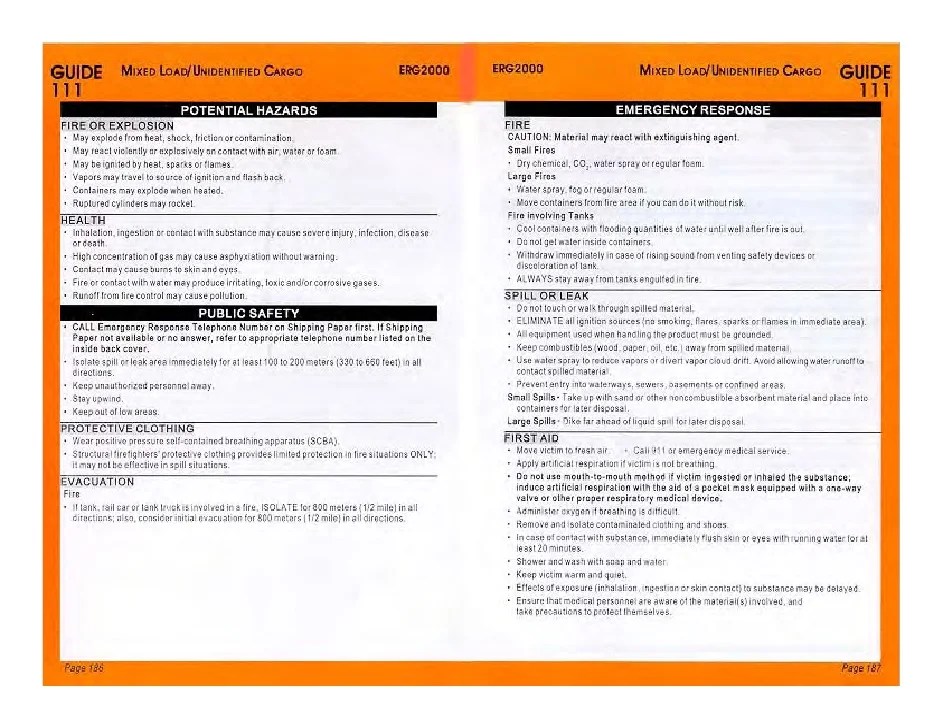Delving into the intricacies of Use Guide 111 in the ERG, this guide provides a comprehensive understanding of emergency response protocols, empowering individuals to navigate hazardous situations with confidence and effectiveness.
Use Guide 111 serves as an invaluable resource for emergency responders and the general public, outlining critical procedures and essential information to ensure safety during hazardous materials incidents.
Introduction to Use Guide 111 in the ERG

Use Guide 111 is an integral part of the Emergency Response Guidebook (ERG), providing vital guidance to first responders in managing hazardous materials incidents. It serves as a comprehensive resource for identifying, classifying, and handling hazardous substances encountered in emergencies.
The guide is meticulously organized, with each hazardous material listed alphabetically. For each substance, Use Guide 111 provides detailed information on its properties, hazards, and appropriate emergency response measures. This user-friendly format enables first responders to quickly access critical information in high-pressure situations.
Structure and Organization of Use Guide 111
Use Guide 111 is structured into several key sections:
- Section 1:Provides an overview of the guide’s purpose, organization, and limitations.
- Section 2:Lists hazardous materials alphabetically, along with their identification numbers, proper shipping names, and hazard classes.
- Section 3:Offers detailed guidance on emergency response procedures, including protective measures, containment, and cleanup.
- Section 4:Includes supplemental information, such as a glossary of terms, conversion tables, and a guide to using the ERG.
Interpreting Emergency Response Information

Use Guide 111 is an invaluable resource for emergency responders, providing critical information on hazardous materials and their potential risks. Understanding how to interpret this guide effectively is crucial for ensuring appropriate and timely response actions.
The guide is organized into several key sections, each serving a specific purpose in guiding emergency response. Let’s explore these sections and discuss how to use them effectively:
Guidebook Index
The Guidebook Index provides a comprehensive listing of all hazardous materials covered in Use Guide 111. Each entry includes the material’s name, CAS number, and page number where detailed information can be found. By referencing the index, responders can quickly locate the specific material they are dealing with and access the necessary response guidance.
Initial Isolation and Protective Action Distances
This section presents tables and charts that provide guidance on establishing initial isolation and protective action distances (PADS) for various hazardous materials. These distances are crucial for protecting responders and the public from potential exposure to hazardous substances. The tables consider factors such as the material’s toxicity, volatility, and dispersion characteristics.
Firefighting Information, Use guide 111 in the erg
The Firefighting Information section offers valuable guidance on extinguishing fires involving hazardous materials. It includes information on the appropriate extinguishing agents, personal protective equipment (PPE), and specific firefighting techniques. By following the recommendations provided in this section, firefighters can minimize risks and effectively control hazardous material fires.
Using Tables and Charts
The tables and charts in Use Guide 111 are designed to be user-friendly and provide quick access to critical information. To use these effectively, responders should:
- Identify the specific hazardous material they are dealing with.
- Locate the corresponding table or chart in the relevant section of the guide.
- Read the table or chart carefully, paying attention to the units and abbreviations used.
- Use the information provided to determine appropriate emergency response actions, such as isolation distances, PPE requirements, and firefighting techniques.
Example Interpretation
For example, if an emergency responder is dealing with a spill of hydrochloric acid, they can refer to Table 2 in the Initial Isolation and Protective Action Distances section. The table indicates that the initial isolation distance for a small spill of hydrochloric acid is 100 feet, while the protective action distance is 500 feet.
This information helps the responder establish appropriate safety zones to protect responders and the public.
Implementing Emergency Response Procedures

Use Guide 111 provides comprehensive recommendations for emergency response procedures, including evacuation, sheltering, and protective measures. Adhering to these guidelines is crucial for ensuring the safety and well-being of individuals and communities during emergencies.
The use guide 111 in the erg provides comprehensive instructions for various tasks. If you’re looking to test your understanding of the unit circle, check out the unit circle fill in quiz . It’s a great way to practice and reinforce your knowledge.
Afterward, you can return to the use guide 111 in the erg for further exploration and guidance.
First responders play a vital role in implementing Use Guide 111 recommendations. They use the guide to guide their actions, ensuring a coordinated and effective response to emergencies. By following the guidance provided, first responders can swiftly assess the situation, prioritize response efforts, and minimize the impact of the event.
Case Studies of Successful Emergency Responses Guided by Use Guide 111
Numerous case studies demonstrate the successful implementation of Use Guide 111 in emergency response situations.
- Hurricane Katrina:During Hurricane Katrina, the use of Use Guide 111 helped guide evacuation and sheltering efforts, reducing the number of casualties and facilitating a more efficient response.
- Boston Marathon Bombing:First responders utilized Use Guide 111 to establish a secure perimeter, evacuate civilians, and provide medical assistance, minimizing the chaos and maximizing the effectiveness of the response.
- California Wildfires:Use Guide 111 has been instrumental in guiding wildfire evacuations, ensuring the timely and safe relocation of residents from affected areas.
Special Considerations for Hazardous Materials Incidents: Use Guide 111 In The Erg
Responding to hazardous materials incidents presents unique challenges and considerations for emergency responders. These incidents involve substances that pose a significant risk to human health, the environment, and property. Managing hazardous materials spills and releases requires specialized equipment and techniques to mitigate the hazards and protect responders and the public.
Coordinating with Hazardous Materials Response Teams
Effective response to hazardous materials incidents necessitates coordination with specialized hazardous materials response teams (HMRTs). HMRTs possess the expertise, training, and equipment to safely handle and mitigate hazardous materials. They provide technical guidance, support, and resources to emergency responders on scene.
Establishing clear communication channels and coordinating roles and responsibilities with HMRTs is crucial for a successful response.
Training and Education for Use Guide 111

Effective use of Use Guide 111 necessitates thorough training and education for emergency responders and the general public. Various programs and resources are available to enhance understanding and proficiency in using this guide.
Training programs should emphasize the following aspects:
- Understanding the structure and organization of Use Guide 111
- Interpreting emergency response information effectively
- Implementing appropriate emergency response procedures
- Handling hazardous materials incidents safely and efficiently
Refresher Courses and Ongoing Training
To maintain proficiency in using Use Guide 111, ongoing training and refresher courses are crucial. These courses can help emergency responders and the public stay updated on the latest revisions and best practices.
FAQ Corner
What is the purpose of Use Guide 111 in the ERG?
Use Guide 111 provides comprehensive guidance for emergency responders and the public on how to identify, assess, and respond to hazardous materials incidents.
How does Use Guide 111 help in identifying hazardous materials?
Use Guide 111 utilizes a standardized hazard identification system, including hazard classes, divisions, and UN/NA identification numbers, to facilitate the recognition and classification of hazardous materials.
What information does Use Guide 111 provide for emergency response?
Use Guide 111 offers critical information on emergency response actions, including evacuation procedures, protective measures, firefighting strategies, and specialized equipment handling.